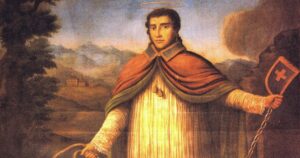
St. Bernard of Montjoux was a priest, missionary, and a caretaker of pilgrims. He is sometimes known as Bernard of Menthon, as some believe him to be of the noble Menthon family, born at the family chateau, but that is not certain. He was born c.1020, most likely in northern Italy or southeastern France. He was well educated, perhaps at Paris. As a young man, he sought out a vocation of service to the Church. Traveling to Aosta, he presented himself to serve under the guidance of the Archdeacon there, named Peter. The position of archdeacon, which dated back to at least the fourth century, can be most closely compared to the position of vicar general in modern times. However, in addition to being the bishop’s chosen administrator, the archdeacon had vast responsibilities including seeing to the needs of the poor and imprisoned, supervising deacons, training clergy, disciplining clergy when necessary, and even to safeguard that the essentials of the Faith were being taught consistent with that of the Apostles. As Peter’s assistant, Bernard progressed quickly in these important skills. Bernard was ordained a priest and was sent out as a missionary to the mountain villages. When it came time to find a replacement for Peter, Bernard’s holiness and wisdom made him stand out and he was chosen as the next archdeacon, placing him directly under his bishop.
GREAT RESPONSIBILITY OF ARCHDEACON
Of all the important duties that Bernard carried as archdeacon, the one of greatest concerns for him was the spiritual and physical care of the people of the mountain villages. Aosta in our day is in far northwestern Italy, quite close to the borders of both Switzerland and France and is located in an Alpine valley. In the eleventh century, there were numerous remote villages in the mountains, and Bernard was troubled by the number of pagan practices that were still present there and the pervasive ignorance of Christ. He devoted himself to converting these people to the One True Faith, and he did win many souls for Christ. It was difficult work in difficult terrain. He labored to build churches and schools to meet their needs. Another matter which weighed upon him was the plight of the many pilgrims from other parts of Europe who had to travel through the Alps on their way to Rome. There are times when the snow is more than eight feet deep, and in the spring, there are avalanches, which occur unpredictably. There are passages which have been used since ancient times. One in particular crosses from the valley of Aosta through the Pennine Alps to the Swiss Canton of Valais. At the top of this pass, Bernard had a hostel built in 1050, more than eight thousand feet above sea level, in order to provide a place for weary pilgrims. He staffed the hostel with canons, who are men who live in community and follow a common rule. He established another hostel located in a passage through the Graian Alps.
A NEW FOUNDATION
Bernard traveled to Rome to obtain papal approval from Pope [St.] Leo IX for these communities. Leo gave his approval and placed the communities under the patronage of St. Nicholas of Myra, a patron for travelers. Bernard gathered together a group of priests to operate the two hostels, and they eventually patterned their community after the Rule of St. Augustine.
The monastery/hostels established by Bernard were remarkable for their hospitality to travelers, not only to those in distress. They were especially appreciated during the months of heavy snowfall. The canons, over time, did some breeding with the large, hardy mountain dogs used for herding, and trained them to search out stranded people and to bring them aid. The canons worked with the dogs to locate and rescue distressed travelers and bring them to the safe shelter. They also were able to locate those who succumbed to the severe weather so that they could have an appropriate burial.

Bernard was known to have worked many miracles, almost none of which were recorded. He is often depicted in works of art as stomping on the head of a demon. He was known to possess remarkable ability to bring reconciliation between bickering parties. Bringing reconciliation between two warring nobles was one of the last things he did. Bernard died at an unknown date in June of 1081 at Novara, currently in northern Italy, in the eleventh century, in the Holy Roman Empire. The dates given for Bernard’s birth vary from as early as 996 to as late as 1020, so it is not known how old he was at his death.
A LASTING MISSION
St. Bernard of Montjoux found a special mission within his missionary work in the southern Alps. He was an effective missionary, bringing many non-Christians to the Faith. The special charism he began for Alpine travelers is still carried on nearly ten centuries later. The Great St. Bernard Pass (on the Italy/Switzerland border) and the Little St. Bernard Pass (on the Italy/France border) still bear his name. There are still safe houses there, staffed by professed religious, which provide hospitality for travelers. The great dog breed, the St. Bernards, are kept as pets. Bernard was canonized in 1681. In 1923, Pope Pius XI, who grew up in the Lombardy region of northern Italy, proclaimed St. Bernard of Montjoux as the patron saint of mountaineering, backpackers, skiers, and hikers. Also known as St. Bernard of Menthon or St. Bernard of Aosta, his feast day is May 28.
